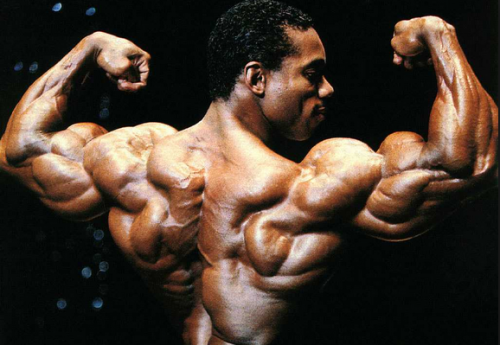My friend Todd is unstable. We live in a world where most of what we’re taught is based on policy and protocol rather than science. The consequences thereof run through basic subjects, like health, nutrition, training advice and even therapeutic practices. This makes me a little unstable too, like Todd, but in a much different way. I’m prone to rants sparked by frustration; Todd falls off ladders.
To combat my issue, I’ll be spending the next several years finding clever ways to bring good information to people in a fun manner starting from the top—magazines, websites and lectures—Todd will start at the base: his feet.
Todd and I trained together some years back and a few months ago had a chance to train together again. Previously, he equaled me in all but the bench press but after a fusion of a couple of cervical vertebrae, he’s been knocked down a few pegs, as anyone would. Now, more than strength, he’s focused on stability. And what better way to become stable than performing balancing movements on BOSU balls. Or so Todd thought.
The body is an incredibly adaptive device. I can’t think of any system—artificially intelligent neural networks, biofilms, slime molds or otherwise—capable of rewiring circuits to compensate for weaknesses or flaws better than the nervous system of the human body. I have a partial tear in my left pec and still worked my way up from a severely weakened 205 max to 405. No, a doctor didn’t repair the damage; my nervous system adapted and created new patterns of firing so I could progress.
I thought about this as I watched Todd doing single-leg, single-arm dumbbell stiff-leg deadlifts on a BOSU ball, hemisphere-side down. What Todd didn’t know is that rather than forcing the correct patterns to fire, he was reinforcing the bad patterns.
We ran a quick experiment. I had him do the same movement without the BOSU ball. Todd wobbled and nearly pitched forward attempting the same movement he’d been practicing on the BOSU ball for 6 months. After the shaky demonstration, Todd said, “I guess I need to spend more time on the BOSU ball.”
I convinced him, as part of the experiment, to just spend two weeks training with me on a radical new training surface, one that’s used by athletes at the bleeding edge of performance. It’s called the floor. Dismayed at the cost (seriously, nothing on the bleeding-edge is ever free) he grumbled but stuck to the program for the agreed upon two weeks. At the end of experiment he balanced perfectly through the movement on either foot with triple the weight he’d been using on the BOSU.
To prove that my method must be deficient in some way, Todd tried the same move on the BOSU ball, hemisphere-side down again. Amazingly, he stabilized better on the unstable surface as well. At that point, Todd bitched because I had the opportunity to say, “I told you so,” and everybody hates hearing, I told you so, although everyone loves the smug feeling that comes with saying it, just like I did at the time.
What had I told Todd? Training on a stable surface—the floor—actually increases stability.
What happened here: why did training on an unstable platform fail to increase stability after six months, when two weeks of using the floor not only increased stability but strength—and with such speed? (For six months, Todd stagnated with the BOSU exercise, which only made him believe he must be as messed up as his chiropractor said.) The reason for the rapid improvement is simple. The human body is far more intelligent than the people who designed the NASM certification program (which leverages unstable training to no small extent).
Think about when you step onto an icy or oily surface. You instantly tense up, you almost literally can’t perform certain movements because the nervous system senses the instability of the environment and fires in resistant ways to keep you balanced. In this process, it also shuts down the ability to produce maximum force (your strength, power, hypertrophy and speed all go down the shitter[1,2]). Think about it, if you start to slip in one direction and your reflexes caused your muscles to fire with maximum force against that motion—a motion that may be inevitable at that point, like falling—then you risk tearing muscle or connective tissue. The body is trying to protect you by making you weaker.
A single fact—that the body will only produce maximum force when it is stable—would be enough to make any sensible person throw away the stability ball, BOSU ball and all the other almost stupidly unstable training surfaces that you see so often in commercial gyms. All of these methods actually prevent the body from getting stronger.
Todd and I discussed this phenomenon at some length but he just kept talking about core training and stabilization. One of the major problems we had to overcome for Todd’s physical performance was that during our training hiatus, he took a NASM certification course—just for shits-and-giggle—and this is often the hardest type of brain injury to correct (NASM also taught Todd that excess protein in the diet gets stored directly as fat which is patently false; good job with the research, NASM).
NASM (and many copy-cat certs) base their entire training strategy on moving from stable training surfaces—like the floor and solid bench—to single leg movements, unstable surfaces then single leg balancing maneuvers on unstable surfaces. I believe they’re under contract with Ringling Bros. as a preparatory program for clowns; that, or they mistakenly extrapolated data from work done with rehab patients. Although I’d prefer to believe the former (because that’s more respectable), the latter is probably closer to the truth.
Most of the stability studies done with instability devices and the magical core-activation, were done with patients suffering injury of some sort, lower-back pain or a re-learning of movement patterns. As this paper describes[3]—in extreme detail—instability training is not training for stability. It’s a possible adjunct at the beginning of training for extremely unconditioned people, but this is still pretty suspect, as exercising on stable devices produces the same increase in stability and the ephemeral core-strength while allowing prime movers to contract more fully. Why train with such ridiculous complex equipment for half the results, when you could get it all done at once? No need to answer, it was rhetorical.
The best possible mode of exercise to increase core stability, strength, power and even bone density, not to mention hypertrophy, is full body movements with heavy loads. Push-press with a 6-rep max overhead, don’t do side-laterals on a bosu ball; dead lift two-times your body weight, don’t try Romanian dead lifts on (in)stability discs.
Increasing load during an exercise is highly effective and equivalent to unstable-surface training for strengthening the core. The difference, however, is that while on an unstable surface, your nervous system never lets you fully contract your muscles, which means stability training on unstable devices (come on, that just sounds stupid, doesn’t it?) is merely a way to waste time in the gym.
Let’s look at some of the data for two major lifts.
- Chest press done on a physio ball vs. stable bench
Well, there was no difference in side-to-side stability between the two and abdominal strength increased more during the flat-bench protocol over the stability ball protocol[4]. This study, as well as another testing specifically for an increase in 6-rep max found that training on the physioball makes you weaker[5]. Although this will increase shoulder and abdominal wall EMG activity[6], it doesn’t translate into core stability, core strength, or performance improvements. So, want a stronger core and stronger pecs? Train on the flat bench. (Note, however, that the right kind of instability is beneficial, such as dumbbells vs. barbell vs. smith machine chest press[7].) - Squats done on unstable surfaces
Squating on increasingly unstable apparati increases core activation, but not necessarily core strength[1] and most definitely decreases force production[8] and hence growth stimuli. Many authors demonstrated, however, that the small increase in stabilizer activity is dwarfed by increasing the force produced (either with more weight or higher force velocity)[9-12]. Researchers noted that squating on instability devices is best left for rehab patients, not healthy people. Want a strong core and a strong squat? Then squat heavy with your feet planted securely on the ground.
Need more? All those cool guys doing pushups with their feet on a physioball? Guess what: it does less to activate stabilizing muscles than placing your feet on an elevated, stable bench[13]. The preponderance of evidence shows that unstable surface training contributes nothing over stable surface exercises[14,15] and stable surfaces are actually better for some rehabilitation scenarios involving scapular rehabilitation[16]. Again, unstable devices seem to be useful for properly diagnosed injuries, but not otherwise[17].
I’m not going to go on, but I could. The simple fact of the matter is that the body wants to be stable if asked to perform meaningful tasks. Even when standing, a cable chest press does not activate core-musculature to the same extent as on a flat bench[18]. The back is unsupported in the standing case. This has to do with hard-wired motor-control programs that require a stable base of support for the primary mover and core to activate fully[19] (motor control programs are an entirely different subject).
How can you utilize this information? That depends on your goals. If you’re trying to increase stability or just starting your training program, the take-home message is simple: stay the hell away from any unstable training surfaces.
I watched a trainer tell her first-time client to repeatedly jump on a BOSU ball, curved-side down, and catch a medicine ball, all in the same movement. The look on the girl’s face said it all, this is ridiculous. In truth, her face only mimed what her body told her, this is fucking ridiculous and stupid. Listen to your body; it’s smarter than your trainer.
Remember, physical therapists developed these methods to help people get to the point of functional movement. Do you honestly think you’ll become a bad ass by training like an invalid?
Featured Image by ~Bowkl
References (click to expand)
- Anderson K, Behm DG. Trunk muscle activity increases with unstable squat movements. Can J Appl Physiol. 2005 Feb;30(1):33-45.
- Drinkwater EJ, Pritchett EJ, Behm DG. Effect of instability and resistance on unintentional squat-lifting kinetics. Int J Sports Physiol Perform. 2007 Dec;2(4):400-13.
- Lederman E. The myth of core stability. J Bodyw Mov Ther. 2010 Jan;14(1):84-98. Review.
- Cowley PM, Swensen T, Sforzo GA. Efficacy of instability resistance training. Int J Sports Med. 2007 Oct;28(10):829-35.
- Saeterbakken AH, Fimland MS. Electromyographic activity and 6-RM strength in bench press on stable and unstable surfaces. J Strength Cond Res. 2012 Jun 11. Epub ahead of print.
- Marshall PW, Murphy BA. Increased deltoid and abdominal muscle activity during Swiss ball bench press. J Strength Cond Res. 2006 Nov;20(4):745-50.
- Saeterbakken AH, van den Tillaar R, Fimland MS. A comparison of muscle activity and 1-RM strength of three chest-press exercises with different stability requirements. J Sports Sci. 2011 Mar;29(5):533-8.
- Saeterbakken AH, Fimland MS. Muscle force output and electromyographic activity in squats with various unstable surfaces. J Strength Cond Res. 2012 Mar 24. Epub ahead of print.
- Freeman S, Karpowicz A, Gray J, McGill S. Quantifying muscle patterns and spine load during various forms of the push-up. Med Sci Sports Exerc. 2006 Mar;38(3):570-7.
- Hamlyn N, Behm DG, Young WB. Trunk muscle activation during dynamic weight-training exercises and isometric instability activities. J Strength Cond Res. 2007 Nov;21(4):1108-12.
- Nuzzo JL, McCaulley GO, Cormie P, Cavill MJ, McBride JM. Trunk muscle activity during stability ball and free weight exercises. J Strength Cond Res. 2008 Jan;22(1):95-102.
- Willardson JM, Fontana FE, Bressel E. Effect of surface stability on core muscle activity for dynamic resistance exercises. Int J Sports Physiol Perform. 2009 Mar;4(1):97-109.
- Lehman GJ, Gilas D, Patel U. An unstable support surface does not increase scapulothoracic stabilizing muscle activity during push up and push up plus exercises. Man Ther. 2008 Dec;13(6):500-6.
- Lehman GJ, MacMillan B, MacIntyre I, Chivers M, Fluter M. Shoulder muscle EMG activity during push up variations on and off a Swiss ball. Dyn Med. 2006 Jun 9;5:7.
- de Oliveira AS, de Morais Carvalho M, de Brum DP. Activation of the shoulder and arm muscles during axial load exercises on a stable base of support and on a medicine ball. J Electromyogr Kinesiol. 2008 Jun;18(3):472-9.
- Martins J, Tucci HT, Andrade R, Araújo RC, Bevilaqua-Grossi D, Oliveira AS. Electromyographic amplitude ratio of serratus anterior and upper trapezius muscles during modified push-ups and bench press exercises. J Strength Cond Res. 2008 Mar;22(2):477-84.
- Tucker WS, Armstrong CW, Gribble PA, Timmons MK, Yeasting RA.Arch Phys Med Rehabil. Scapular muscle activity in overhead athletes with symptoms of secondary shoulder impingement during closed chain exercises. 2010 Apr;91(4):550-6.
- Santana JC, Vera-Garcia FJ, McGill SM. A kinetic and electromyographic comparison of the standing cable press and bench press. J Strength Cond Res. 2007 Nov;21(4):1271-7.
- Bouisset S, Do MC. Posture, dynamic stability, and voluntary movement. Neurophysiol Clin. 2008 Dec;38(6):345-62.










Recent Comments